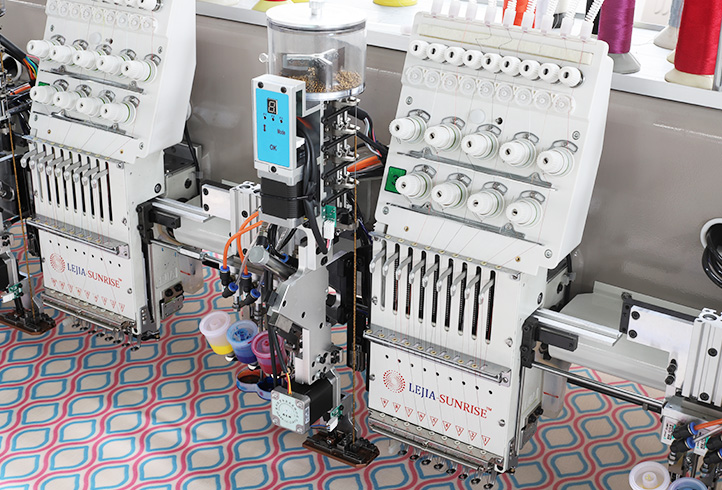

There are many types of computer quilting machine performance, so if you want to buy a good quilting machine, it mainly depends on the materials used in the key parts of the machine, such as the motor, timing belt, and head. If you use plastic or nylon parts for the synchronous wheel and synchronous belt, you have to be careful. It will not take long. It also depends on the material specifications of each part. If the square tube is less than 8*8, the stability of the machine must be considered.
Features :
1. Thinness adjustment function: to adjust different thicknesses, you can adjust the depth of quilting according to relevant instructions.
2. Pattern storage function: The computer quilting machine disk can store patterns for a long time, and users can choose to add patterns according to their needs. Its operation is simple, convenient and fast.
3. Set the line step function: strong reliability, uniform line step, and the pattern is not easy to deform. Rotary shuttle function: can effectively prevent thread breakage.
4. Broken wire detection function: When the wire is broken, the system automatically stops. Land use rate: The computer quilting machine occupies a small area, but the quilting size is large.
5. Information display function: You can see the spindle speed, stopping factors, output statistics, remaining memory, etc. on the display.
6. Safety device: abnormal phenomena such as computers, motors, machines, etc. will automatically stop, and the screen will show fault content.
7. Reinforcement sewing function: After the reinforcement quilting function is turned on, the quilting machine will automatically quilt back and forth stitches at specific points.
8. Power-off memory function: When the power or power is cut off during the operation, or when the quilting machine (needle or thread) has a problem and needs to be stopped, the computerized quilting machine can automatically and quickly follow the pattern movement route Fast forward or rewind the route. And when you need to continue quilting. It can automatically or manually return to the quilting point when the machine is stopped for continuous quilting.
9. Pattern function: The pattern is expanded or reduced by 50%-200% horizontally and vertically on one side, and the unit is automatically repaired in 1%. During the operation, the missing line is caused by broken or no bottom line. It can automatically or manually use the designated needle to return along the stitch direction for mending.

Movement situation: Computerized quilting machine and quilting machine have the same principle, and both use XY-Z movement system. The XY axis controls the movement of the machine head; the Z axis controls the quilting of the machine head.
(1) Movement in the Z-axis direction-the machine head and the machine base are controlled by a stepper motor to operate synchronously
(2) Movement in the X-axis direction—the head of the quilting machine moves left and right;
(3) Movement in Y-axis direction—the head of the quilting machine moves forward and backward.
The shortcomings are summarized: (1) The computer quilting machine is difficult to maintain; (2) The operation also requires a certain computer basis; (3) Compared with the ordinary quilting machine, the price is higher.
Classification introduction: Single needle computerized quilting machine is a kind of computerized quilting machine. It has only one head, so it is called single needle computerized quilting machine. It is widely used for quilting of various quilts, sleeping bags, bedspreads and curtains.
Its advantages are: good machine stability, low price, adjustable pattern size, simple operation, good quilting thickness, uniform stitch size, silent machine, etc.
Mechanism of action Take bedding as an example. Bedding is generally composed of two parts, tire material and outer textile. The tire material is divided into floss and loose fiber. The core structure and shape of the loose-fiber quilt are not fixed, flow and shrink, and the thickness is uneven. In order to make the outer layer of the quilt and the inner core tightly fixed and make the thickness of the quilt uniform, the outer layer of woven fabric and the inner core are stitched together (including stitching) in a side-by-side linear decorative pattern, which increases the beauty and The practical process is called quilting.